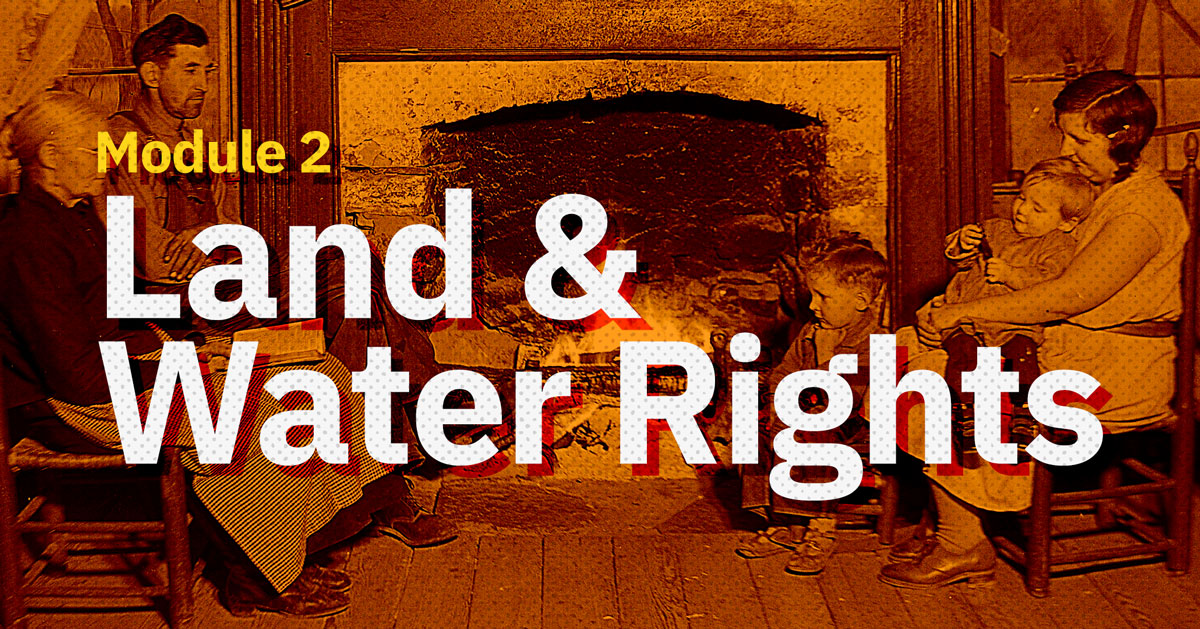
Module 2: Land & Water Rights
In this lesson, students will explore the U.S. government’s use of annexation and eminent domain in both rural and Indigenous communities. Students will examine if rights have been protected or denied to these groups. The history of Indigenous peoples in this country has been marked by profound tragedy since explorers and colonizers first arrived in North America, while rural communities in the United States have long been marginalized and underserved.
Lesson Plan: Day 2
- Welcome the students to social studies class.
- Using your routine strategy for setting up groups, divide the class into small teams of three to four members.
- Distribute the Observe & Wonder image set.
- Distribute the Observe & Wonder Organizer and instruct students to work collaboratively to take a close look at the images in order to complete the organizer.
- Using slide 5 of the Land & Water Rights: Rural Communities slide deck, review activity to ensure students understand expectations.
- Circulate around the room, encouraging each team, observing progress, and redirecting as needed.
- Return to a full-class format and allow students to briefly share their observations.
- Using slide 6 of the Land & Water Rights Rural Communities slide deck, support students in making close observations of Image Set 1.
- Wood stove provides heat
- Large windows provide light
- There is no electrical lighting in the room
- Door to classroom appears to be open to outside, allowing in light
- Youngest students sit in front with no desk
- Mixed-aged students fill the classroom; possibly a one-room schoolhouse.
- Follow up with slide 7 of the Land & Water Rights: Rural Communities slide deck to provide details on the image.
- Using slide 8 of the Land & Water Rights: Rural Communities slide deck, support students in making close observations of Image Set 2.
- Fireplace provides heat and may serve as way for cooking meals
- Oil lamps provide light
- Room is sparsely furnished; the wickerwork chairs are most likely handmade by family members
- Spinning wheel used to create fabric to make clothes and linens
- Embroidered fabric decoration on mantle was most likely handmade by family member
- It appears the extended family lives together
- Follow up with slide 9 of the Land & Water Rights: Rural Communities slide deck to provide details on image 2.
- Facilitate a class discuss by asking the following questions:
- What do these images have in common?
- How are these images similar or different from life in your community?
- Using the maps on slide 10 of the Land & Water Rights: Rural Communities slide deck, tell students that today we will begin to explore life in rural America, with a specific focus on communities in the Appalachian Mountains and an area known as the Tennessee Valley.
- Remind students of the inquiry question: “Who has the right to own land and water?”
- Allow students time to offer wonderings and observations.
Universal Design for Learning (UDL)
- Students are introduced to the topic through visual discovery to support concept attainment.
- Allow sufficient wait time for students to formulate an opinion and offer feedback.
- Consider allowing students trio time to formulate answers.
Multilingual Learners (ML)
Social-Emotional Learning (SEL)
Civic Skills & Dispositions
Extending Learning
- Refer to the vocabulary slide deck for Day 2 (slide 18) and use “this or that” word sorts by using vocabulary words in a sentence, inserting the word “blank” in place of the vocabulary word then having students call out the vocabulary word they think fits best.
- Using slide 11 of the Land & Water Rights: Rural Communities slide deck, discuss the definition of eminent domain: Eminent domain refers to the power of the government to take private property and convert it into public use. The Fifth Amendment provides that the government may only exercise this power if it provides just compensation to the property owners.
- Tell students that local, state, and federal governments exercise the power of eminent domain when the land will be used to serve the greater good. However, while some might benefit from a new public space or project, others are forced to leave their homes and communities. Eminent domain is a controversial topic. Some eminent domain examples include the following projects:
- Kinzua Dam, Western Pennsylvania
- Central Park, New York City
- Hoover Dam, Arizona and Nevada
- Dallas Cowboys’ AT&T Stadium, Dallas
- Shenandoah National Park, Virginia
- Tennessee Valley Authority, Tennessee
- Provide space for students to share thoughts and observations that surface after considering the process of eminent domain.
- Tell students that they will set out on a voyage to discover the history of the Tennessee Valley Authority to determine if the U.S. government had the right to take the land from the rural communities in Tennessee.
- Set up five stations around the classroom, placing one stop from the Exercising Eminent Domain in the Tennessee Valley Stops at each station.
- Distribute copies of the Exercising Eminent Domain of the Tennessee Valley Evaluator, and review to ensure students comprehend expectations.
- Students will visit each stop to investigate the primary source. In their Exercising Eminent Domain of the Tennessee Valley Evaluator, students will closely examine each source to determine if it is in support of or opposition to the use of eminent domain and provide evidence to support their claim. Use slide 12 of the Land & Water Rights: Rural Communities slide deck to explain the procedure.
- Using your routine strategy for setting up groups, divide the class into small teams of four to five members and assign each team to one of the respective stations.
- Allow students to work collaboratively to observe and analyze each station.
- Rotate teams to ensure they visit each station.
- Circulate around the room, encouraging each team, observing progress, and redirecting as needed.
Universal Design for Learning (UDL)
- Utilize the Land & Water Rights Rural Communities slide deck for vocabulary support starting on slide 16.
- Educator might model how to use the Exercising Eminent Domain of the Tennessee Valley Evaluator by completing Stop #1 in the Exercising Eminent Domain in the Tennessee Valley Stops together.
- Alternatively, each group could be assigned only one of the Exercising Eminent Domain in the Tennessee Valley Stops and share out in a modified jigsaw format. However, a fuller understanding of the eminent-domain events and a richer class conversation will result in students exploring all five stops.
- History Brief: The Tennessee Valley Authority video may be used to support concept attainment for emerging readers. Utilize video transcript to support comprehension.
Multilingual Learners (ML)
Social-Emotional Learning (SEL)
Civic Skills & Dispositions
Extending Learning
- Return to a full-class format and briefly review each of the Exercising Eminent Domain in the Tennessee Valley Stops, which may include the following:
- Stop 1: TVA—Generally, this source supports the use of eminent domain to create the TVA, although it does reference that some residents were opposed because they were forced to leave their homes.
- Stop 2: Map—This source supports the use of eminent domain to create the TVA, as it explains the benefits of dams to create hydroelectric power and control flooding.
- Stop 3: Life Before TVA—This source supports the use of eminent domain to create the TVA because it explains the obstacles rural communities faced.
- Stop 4: Grit Photos—These sources oppose the use of eminent domain to create the TVA as they describe the resourcefulness of the hardworking families that lived on the land.
- Stop 5: Mattie Randolph—This source opposes the use of eminent domain to create the TVA as it details one family’s refusal to sell their home and relocate.
- Teachers may wish to utilize slide 13 of the Land & Water Rights: Rural Communities slide deck to drop and drag each station in the For or Against Exercising Eminent Domain table.
- Facilitate a class discussion by asking the following questions:
- Why might some families have been opposed to the TVA project?
- Why were some families in favor of the TVA project?
- What are two ways the TVA might improve life in rural Tennessee?
- What are two ways the TVA might hurt the lives of residents in rural Tennessee?
- Did the United States act in the best interests of the rural community members when exercising eminent domain in rural Tennessee?
- Thank students for participating in this civic conversation.
Universal Design for Learning (UDL)
- Allow sufficient wait time for students to formulate answers and offer feedback.
- Consider allowing students trio time to formulate answers.
- Alternatively, students may create a written or audio response to the discussion questions.
Multilingual Learners (ML)
Social-Emotional Learning (SEL)
Civic Skills & Dispositions
Extending Learning
- Distribute How Would You Decide Eminent Domain? resource sheet and utilize slide 14 of the Land & Water Rights: Rural Communities slide deck review to ensure students comprehend expectations.
- Working in teams, students will read each scenario to determine if the individual would support or oppose the use of eminent domain by the U.S. government in the rural Tennessee communities. Remind students to explain why they made that decision and provide evidence for their claim.
- If time allows, each team can work collaboratively to create their own scenario to share with another team to solve.
- Play the Student-Created Video and as students watch, they should listen for examples of land and water rights that the students provided.
- Play the video a second time to ensure comprehension.
- Facilitate a brief class discussion encouraging students to think about land and water rights in their own community and answer the following:
- Does everyone have access to the land and water, or has land or water been claimed by individuals, companies, or even the U.S. government?
- What impact does this have on your lives and your community?
Universal Design for Learning (UDL)
- Allow for students to record answers in written or audio format.
- Encourage group members to probe each others’ thinking with questions such as:
- Why do you think that?
- What makes you say that?
Multilingual Learners (ML)
Social-Emotional Learning (SEL)
Civic Skills & Dispositions
Extending Learning
- Students will create an advertisement poster to answer the supporting question: “Did the U.S. government have the right to take the land in rural Tennessee by exercising eminent domain?”
- Using slide 15 of Land & Water Rights: Rural Communities, tell students that posters must answer the question and include at least three reasons to support their claim.
- Support students in poster creation by providing suggestions, such as the following:
- Catchphrase or caption (Ex: “Power for All” or “Leave Us Alone”)
- Sentence starter: Our community needs / does not need the TVA because …
- Illustration to enhance understanding
- Conduct a class poll allowing students to take a stand and vote on the supporting question: “Did the U.S. government have the right to take the land in rural Tennessee by exercising eminent domain?” Vote may be conducted by a secret ballot or a show of hands.
- Display results and thank students for participating in this democratic experience of voting.
- Probe students’ thinking to explain their reasoning behind their vote on the supporting question.
- If time allows, display advertisements around the room for students to participate in a gallery walk to observe the creations of their classmates.
Universal Design for Learning (UDL)
- To scaffold learning, students may benefit from completing the Pros & Cons of the TVA to inform their choice in creating the poster advertisement.
- Alternatively, students could answer the supporting question in written or audio format.
- Support students’ understanding by modeling one example using the sentence starter: Our community needs/does not need the TVA because …
Multilingual Learners (ML)
Social-Emotional Learning (SEL)
Civic Skills & Dispositions






